Can humans and paper wasps live together in peace?
Two years ago, a couple of paper wasp nests appeared under the roof of my covered patio, and I decided to leave them there and see we could coexist.
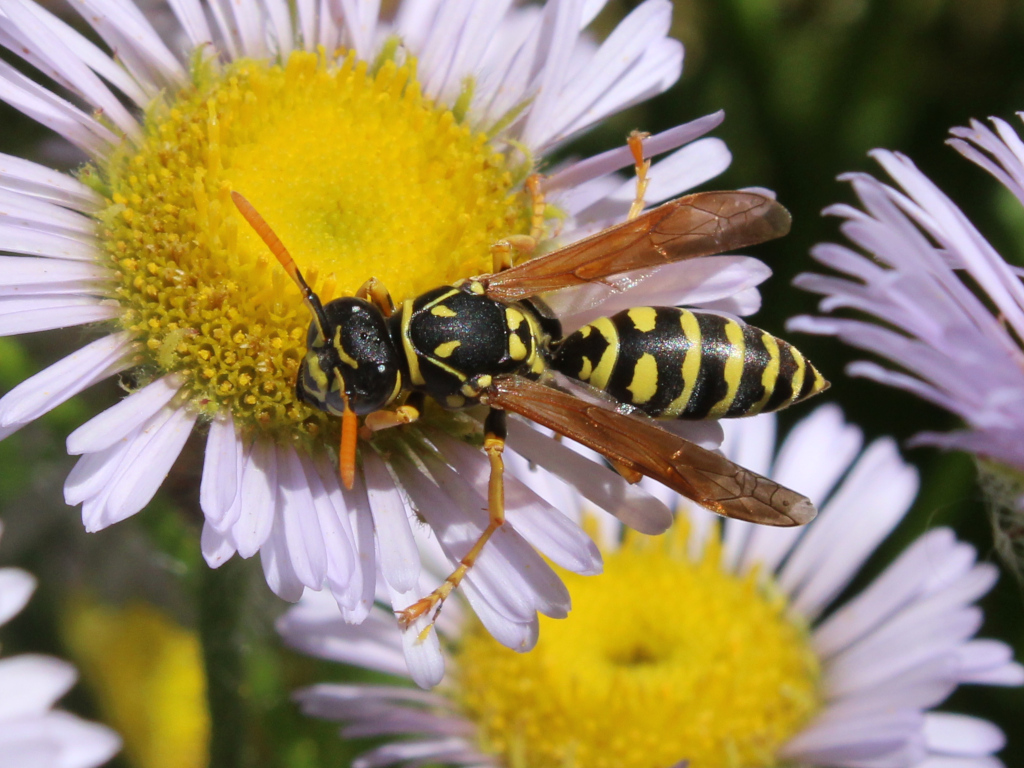
This is the European paper wasp, Polistes dominula. It looks a lot like a yellowjacket, but with a narrower body and longer legs that dangle below when it flies. Another distinguishing feature is its antennae: they are mostly orange, in contrast to the all-black antennae of yellowjackets.
As you can guess by the name, the European paper wasp is not native to the U.S. It was accidentally introduced to the East Coast in 1978, and it has since invaded the West Coast as well. It has flourished in this country, outcompeting native paper wasp species.
In my garden, I see the European species every day during the growing season, while I have never seen a native paper wasp. Rather than asking “Can we get along?”, therefore, the better question may be “Should we get along?” Should we tolerate these invaders when they may displace our native species? Because they prey upon many insects that are themselves considered invasive pests, some would argue that they may as well stay. In any case, they are too numerous to eliminate now.
One way that European paper wasps outcompete native species is by getting a jump on the season. Overwintering queens emerge from dormancy before other species. They can be spotted in the Portland area in early March if the weather’s mild. Females start looking for a place to build their nest at that time, preferring sheltered spaces like porches, eaves, sheds, and birdhouses. They fight over the choicest spots.
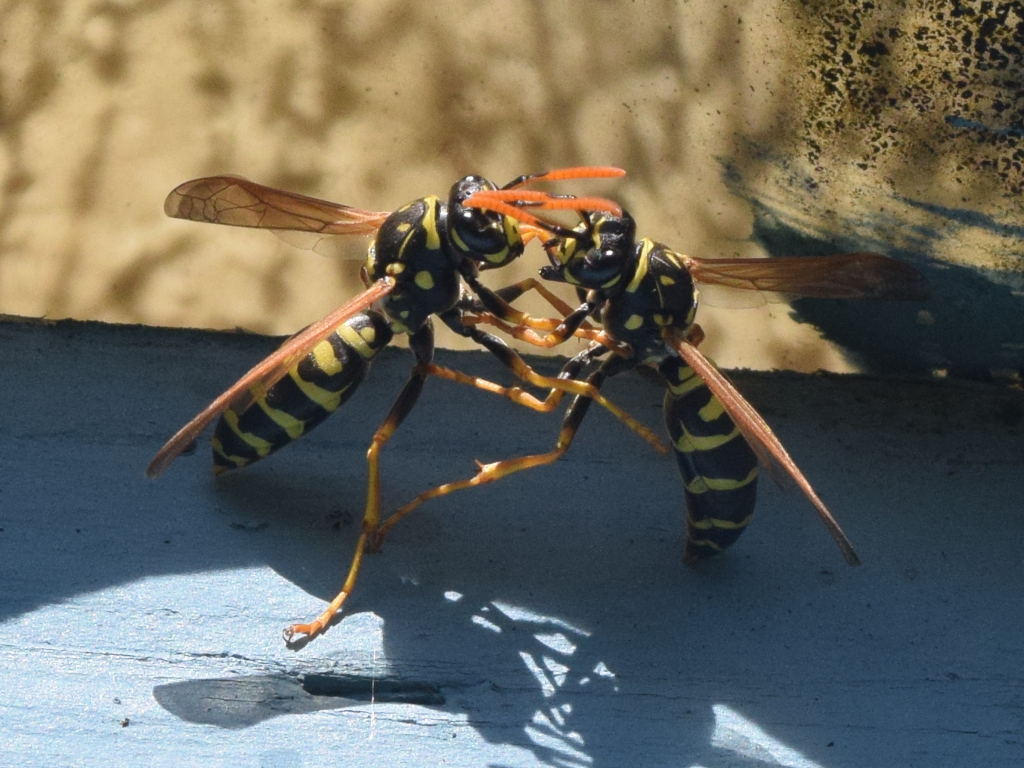
I caught these two brawling on the rafters of our patio.
Despite their cantankerousness, up to four females, known as foundresses, may agree to build a nest together. Eventually, one dominant individual will emerge as the queen and only she will lay eggs. The other foundresses will help build the nest and raise the offspring.
Unlike yellowjackets, which nest in the ground, paper wasp nests are suspended aboveground, and unlike hornet nests, which are enclosed in a papery covering, paper wasp nests are exposed and are comprised of just a single layer of cells.
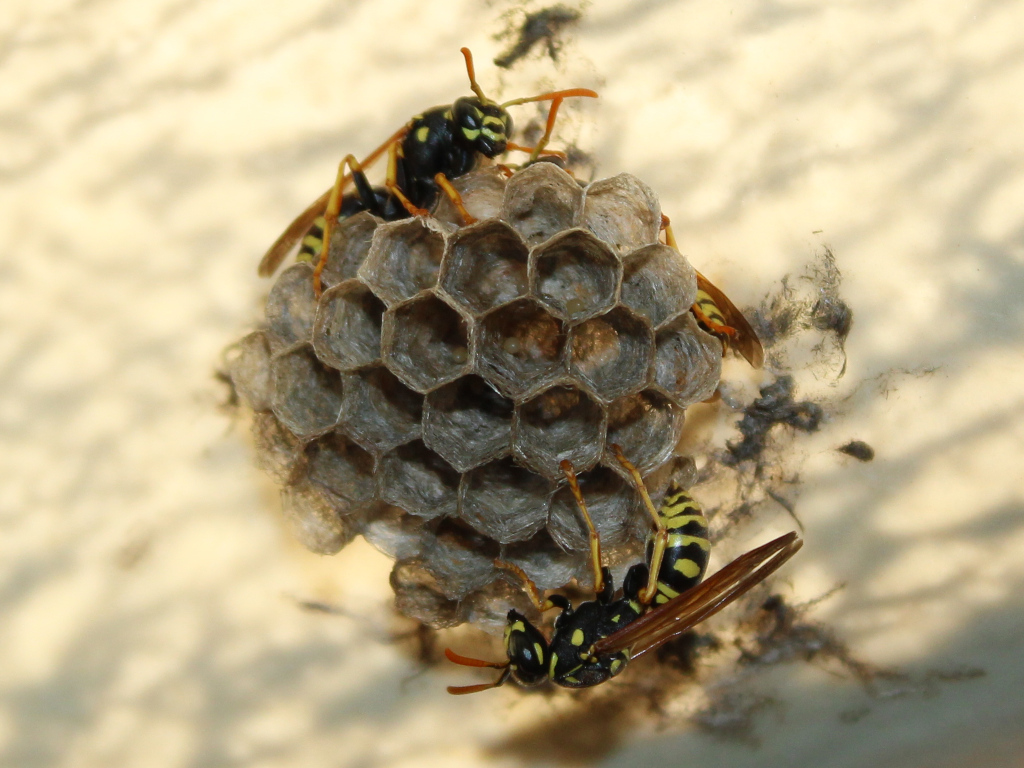
The queen lays one egg in each cell, which you may be able to see in this photo. Each new wasp will complete its development inside its cell, progressing from egg to larva to pupa to adult. European paper wasps mature faster than native paper wasps, another factor in their success here. Only females are produced at first, and they will become workers.
Worker wasps construct the nest from wood fibers, which they collect with their mandibles. Weathered wood from manmade structures is a popular source.

Here, a paper wasp chews off fibers from my cedar fence.
First, though, she must collect water, which she’ll store in her crop to mix with the chewed-up wood fibers to make a pulp. When building their nests, paper wasps regularly visit this water dish I put out for the birds.
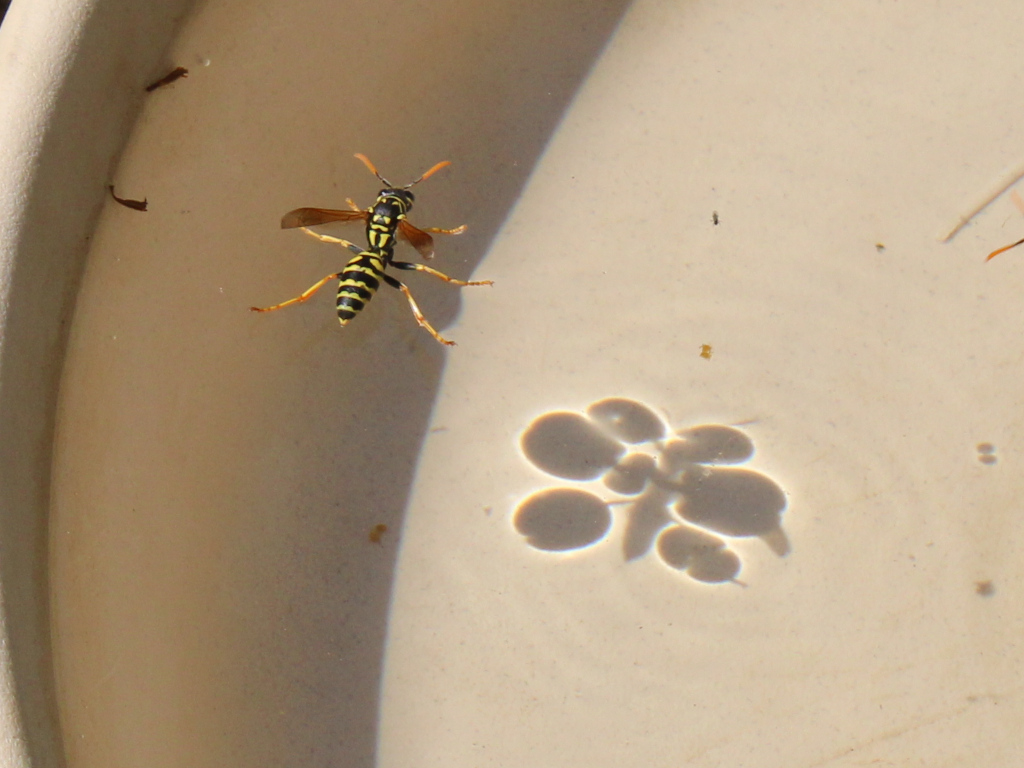
On hot days, they seem to really enjoy this part. I’ll find them floating idly like vacationers at a hotel pool.
By the way, you’re often advised to put out a shallow dish of water for the bees, with some gravel in the bottom so they don’t drown. Don’t bother. Bees get all the water they need from the nectar they drink. You’ll only get paper wasps. Birds, however, will appreciate a proper birdbath.
Worker wasps hunt insects to feed the offspring. Many paper wasps specialize in hunting caterpillars, but European paper wasps feed on a variety of insects; this adaptability is yet another factor in their success. They do relish caterpillars as well.
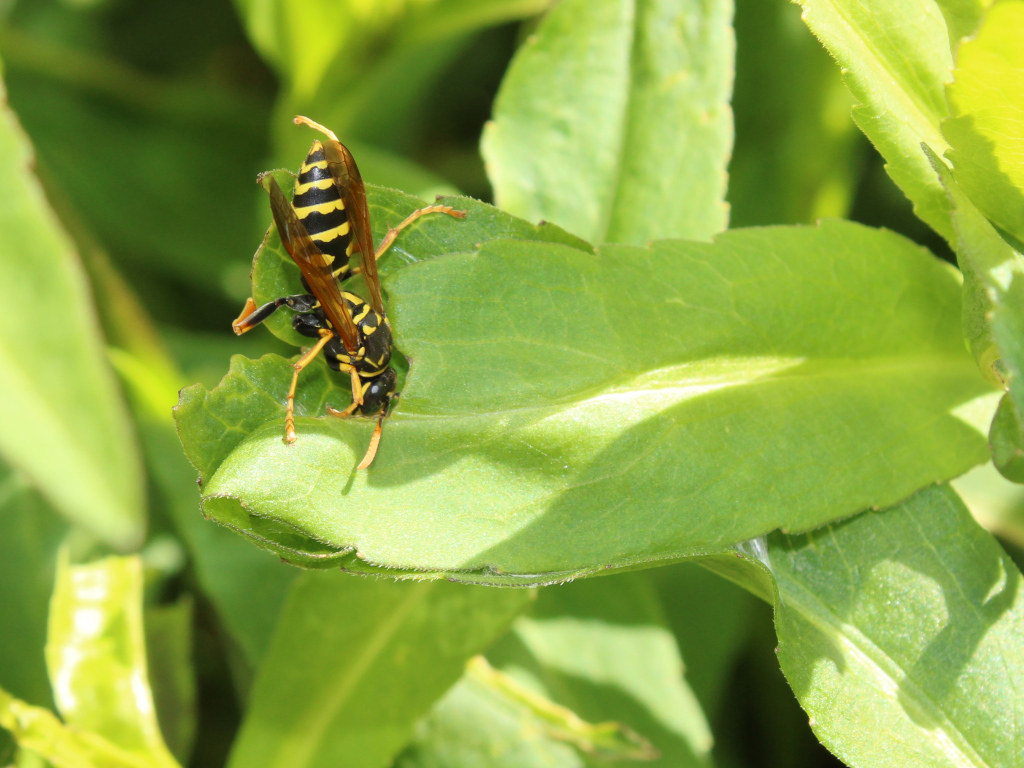
Here, a worker is patrolling in my garden. Many caterpillars will hide from predators in a folded leaf, but this wasp is wise to the trick. She investigates one end of a folded Douglas aster leaf but can’t break in.
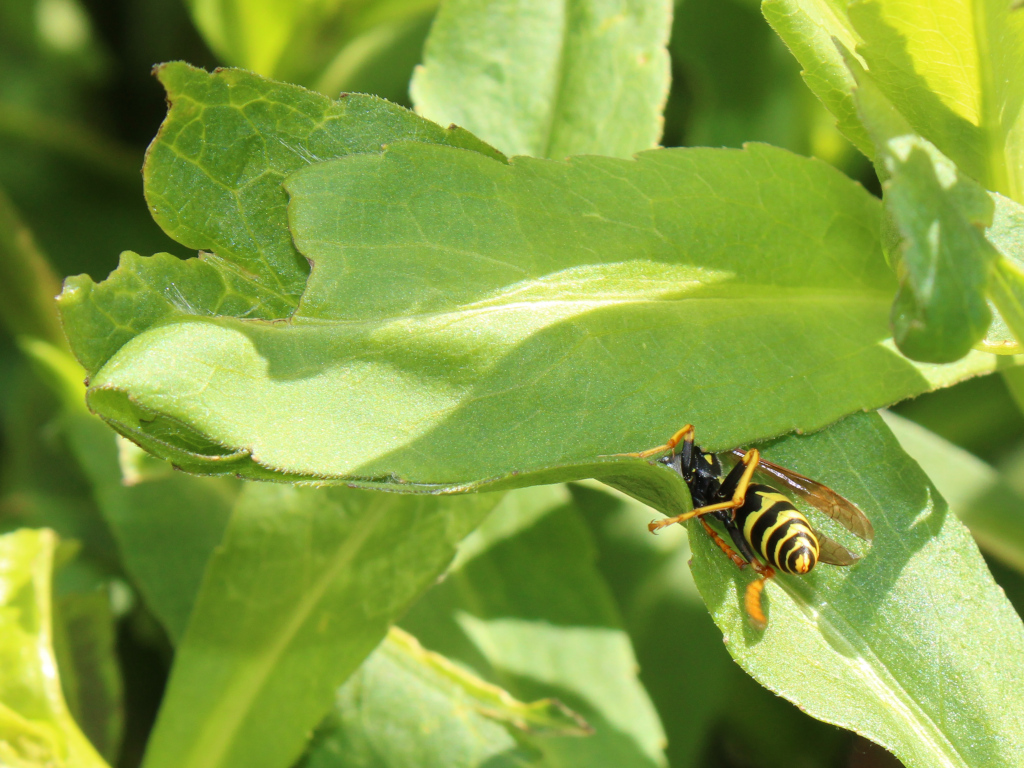
She goes around to the other end and pokes her head in. Hello, anybody home?
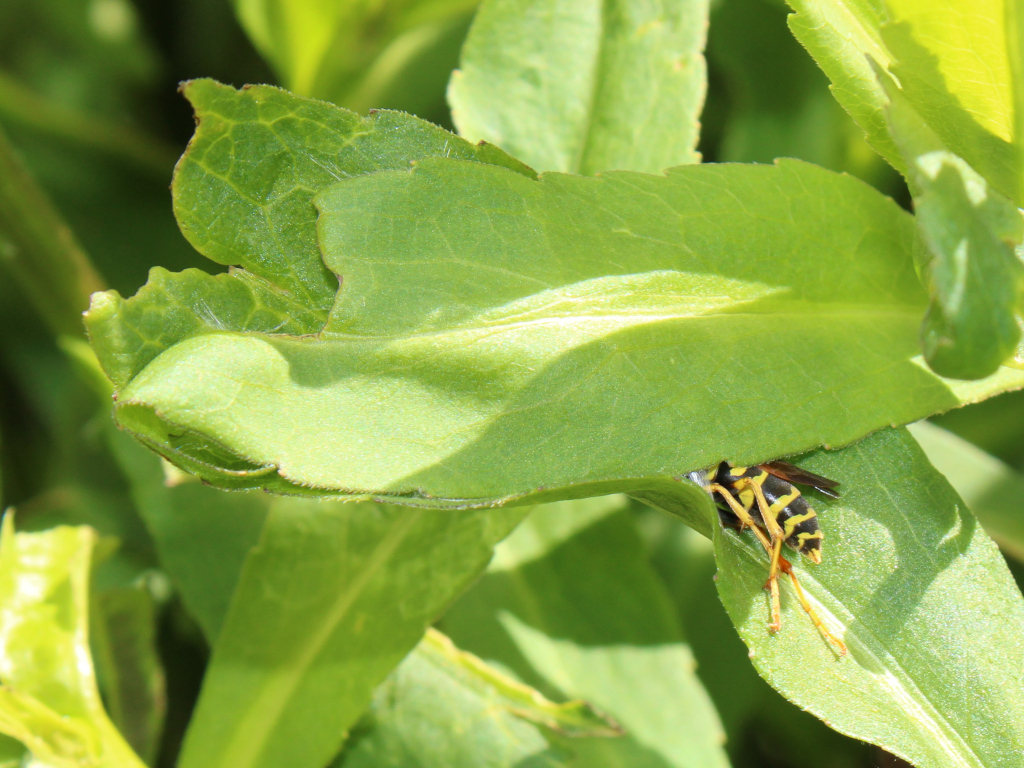
She goes in further, her long legs stretched out behind her.
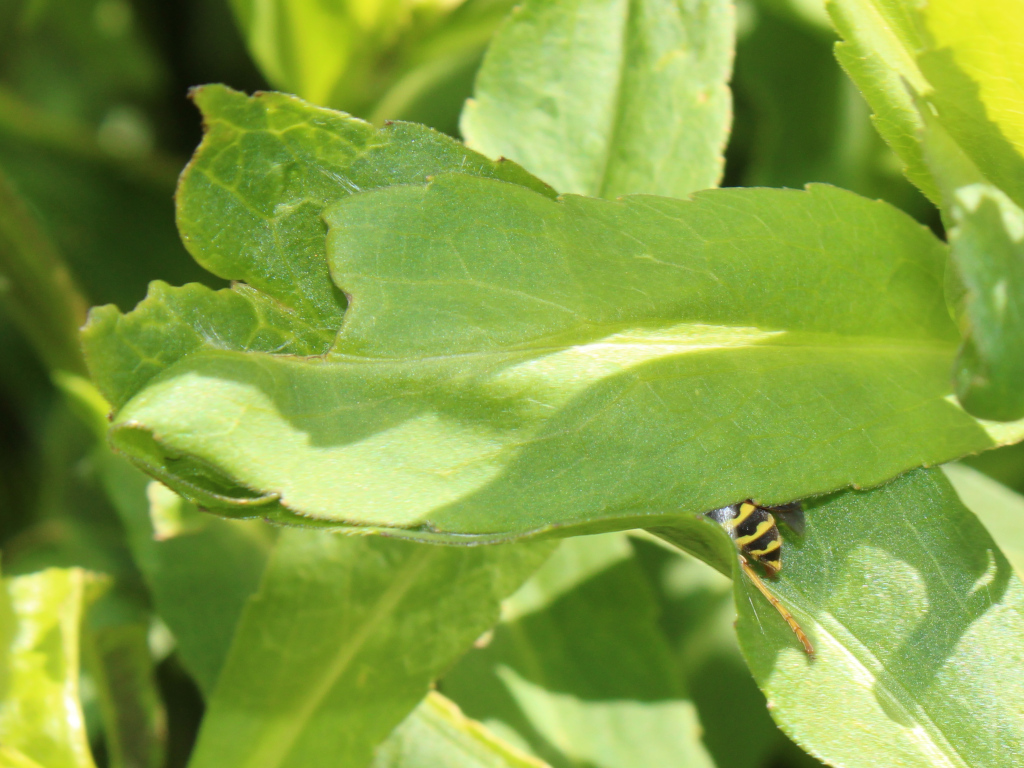
She dives in all the way, and then…
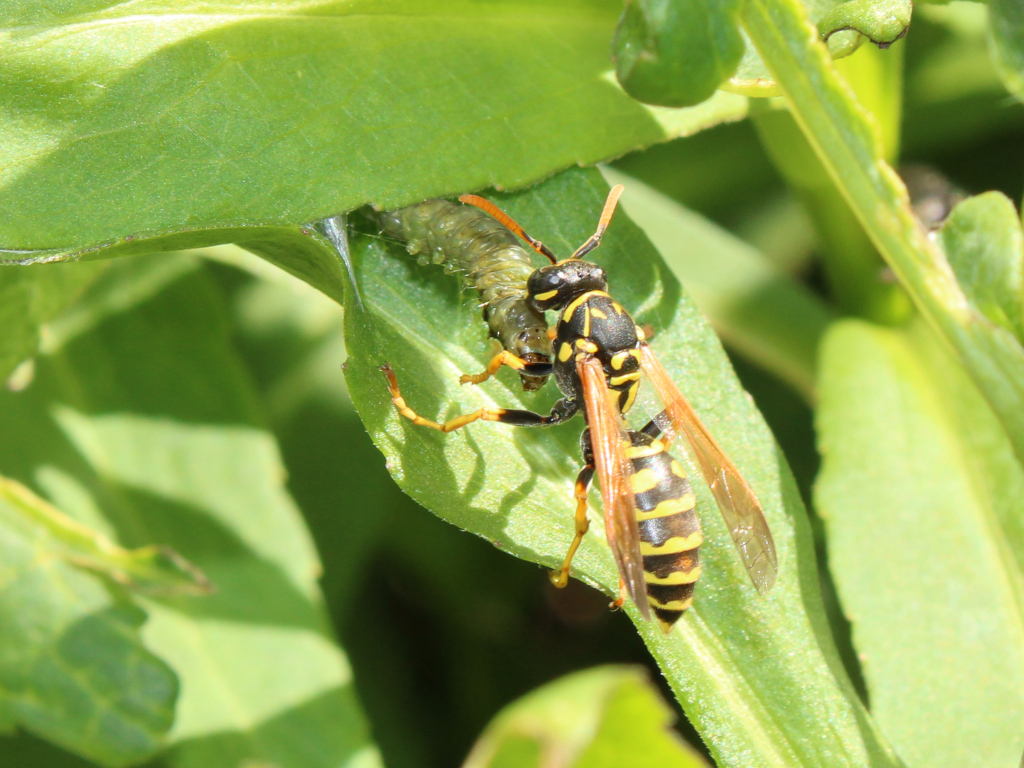
Success!
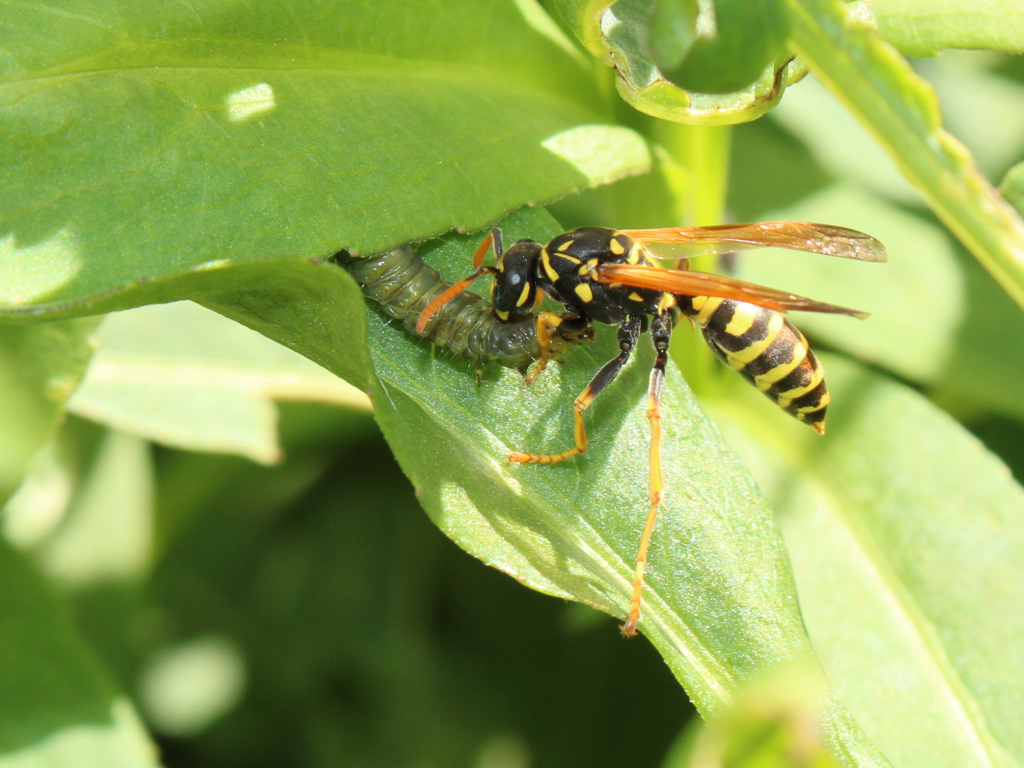
She doesn’t sting her prey like some other wasps, but starts chewing it up right away.

Back at the nest, she’ll regurgitate some of the unfortunate insect to feed to the youngest larvae. The older ones will get some larger, chewed-up pieces.
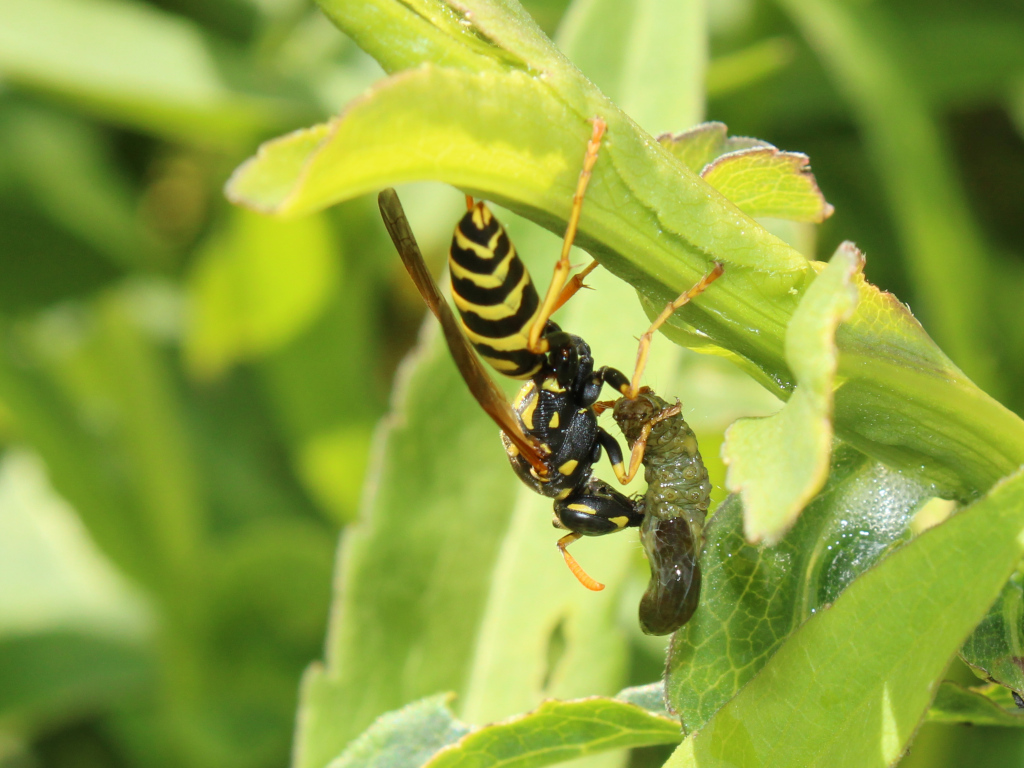
She may also ingest a little of the caterpillar goo to nourish herself.
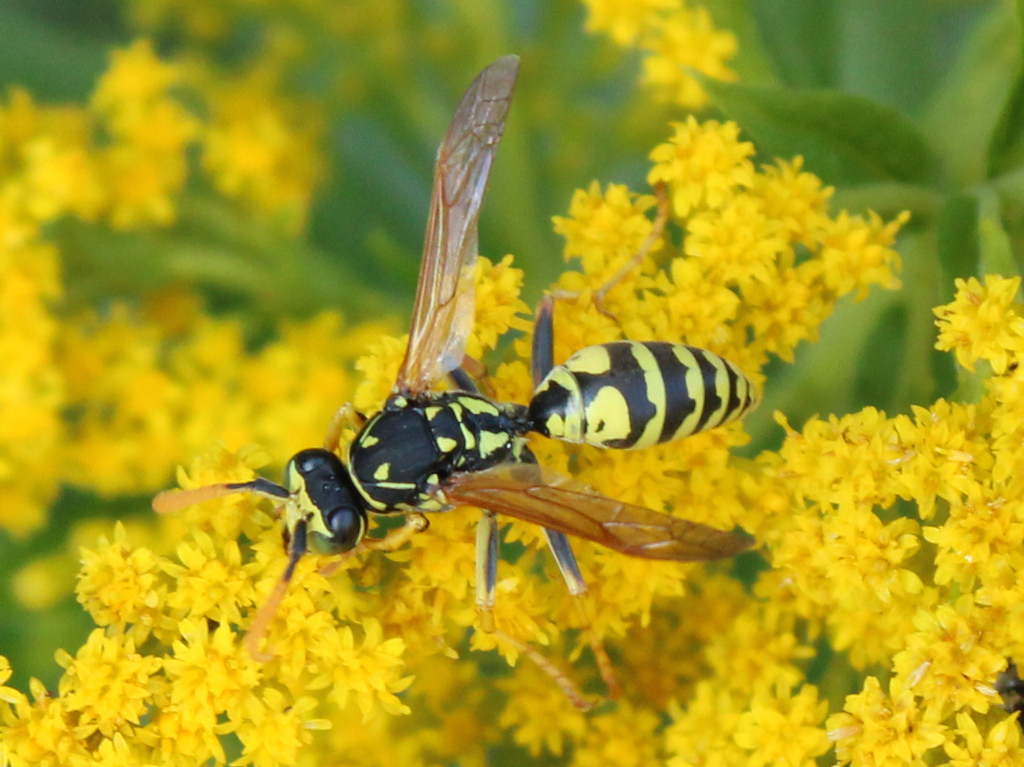
Adults also feed on nectar and can be seen on many different flowers, like this goldenrod. This is a male. You can tell by his solid yellow face and the way his antennae are hooked on the ends. Male paper wasps, by the way, like all male wasps and bees, have no stinger and are completely harmless. Males are produced later in the season, along with females that will become next year’s foundresses. They mate, and everyone except the new foundresses will die. These survivors will seek out a sheltered place and will overwinter there in a state of torpor.
In fall, the nest is abandoned. That’s when I took my nests down. I’ve read that European paper wasps will reuse an old nest, and I didn’t want the two small nests to become two huge nests. Plus, I just wanted to have them to admire.
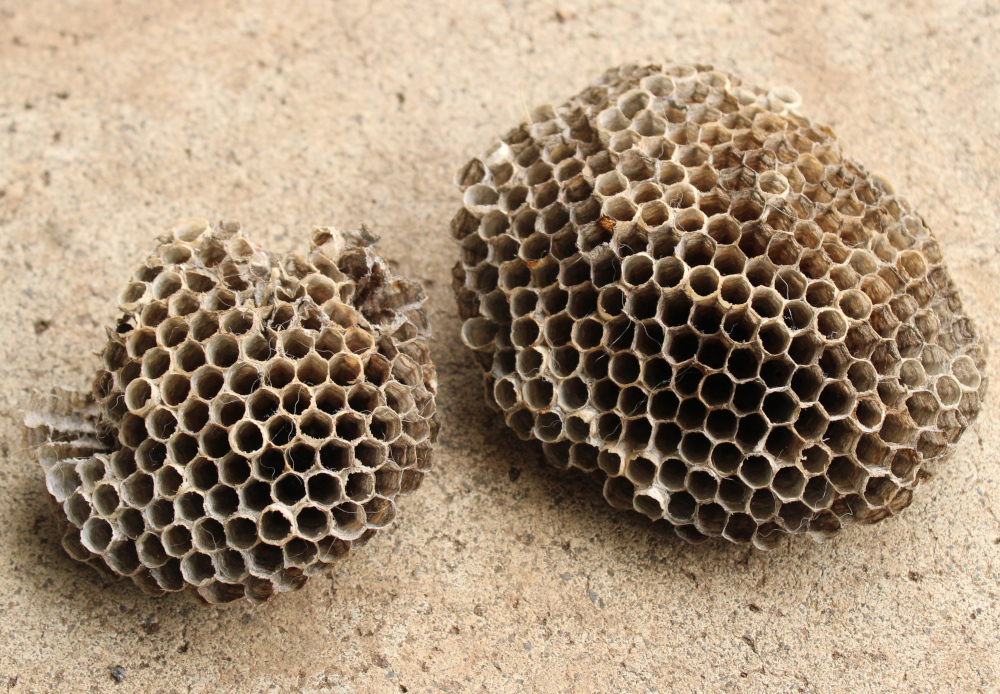
They really are an amazing feat of engineering.
I know people who have been stung by paper wasps, and apparently it is quite painful—more painful than a yellowjacket sting. But fortunately, paper wasps are much less aggressive than yellowjackets. In my experience, they were well-mannered guests. I passed within a few feet of their nests many times and was never harassed in any way. So, yes, humans and paper wasps can live in peace together.
Should I continue to tolerate the European paper wasps in my garden, though, given their invasive tendencies? That question was answered for me the next year in an unexpected way. In early spring, two nests were constructed in exactly the same spots where the previous ones had hung. I decided to let them be, but in early June they were destroyed.

A scrub jay swooped in, pecked them down, and made a meal of the contents. As loud and obnoxious as the jays are, squawking and screeching all summer, it was nice to see a native resident have the final word.


Riveting story of a paper wasp. Fabulous writing, as to be expected. Keep ’em coming, Amy. Your posts are a delight. Cheers
Thank you so much, Patricia! I really appreciate you taking the time to tell me that.
Brilliant piece! Thank you for shining light!
Thank you for reading my blog and taking the time to comment!
Oh what a tale you tell! I have to admit I couldn’t help but wonder about your photos. The one where the curious and smart wasp gets the hidden caterpillar for example. I picture you sitting in your garden for hours, camera in hand, watching and waiting…
That is exactly what it looks like. On my days off, when it’s sunny, I wander around the garden for hours with my camera around my neck. I never know what I’m going to see. It’s like a little backyard safari every day!
Whoa….those little buggers! Very interesting and informative write up, Amy, as always. They do tend to be less aggressive than yellowjackets, I agree. I do however note that honey bees (I know they get a bad wrap these days and are no longer considered beneficial pollinators by many) do indeed enjoy water in summer. I see them gathering on rocks I have in our birdbaths drinking regularly, for three full seasons.
*bad rap*….ha ha…not enough coffee yet
Yes, you will get some honey bees, too, but I am among those who see the European honey bee as a pest, competing for resources with our native bees and potentially spreading diseases to them. Honey bees are amazing in what they can do, and I do love honey, but they have no place here in the city imho.
Fascinating post! Also enjoyed the piece you did for Garden Rant. I have subscribed to your blog and look forward to future learning from you. Might do a bit of reading “backwards” to learn, too! I like knowing more about the critters I share my quarter acre with. Thanks!
Thank you so much! I have a lot more to say and am planning on writing regularly about gardening for insects and other wildlife. I find it so addictive!
Those damn Europeans… Seriously, this was a very interesting read, and the photos are great! I had the same vision of you sitting for hours, just watching and waiting, that Loree did. Obviously it pays off – thank you for sharing your discoveries!
Thanks, Anna! There are all sorts of little dramas going on in the garden all the time that I just wasn’t aware of. It’s super-entertaining.
Hi Amy,
Love your blogs! Thank you!
I wanted to respond to one of your comments, “By the way, you’re often advised to put out a shallow dish of water for the bees…Don’t bother. Bees get all the water they need from the nectar they drink.”
This statement is actually incorrect. Honey bees drink water, use it to feed young bees, and use it to regulate the temperature in the hive. The gathered water is spread in a thin layer over the surface of the comb; the bees fan the water with their wings to evaporate it and cool the hive. They also use it to de-crystalize (thin) honey to make it easier to consume. Some researchers also think they obtain minerals from the water.
We keep honey bees, and when the weather is hot (it’s been brutal in Pennsylvania this summer), I have upwards of 20 honey bees on both of my bird baths and also on two other water stations on the property. I get a few paper wasps too, but many more honey bees.
Thanks for your blog.
Angie
Hi Angie,
Thanks for reading! Yes, water will certainly attract honey bees, but I don’t like to encourage them in my garden. They compete for resources with the native bees and can potentially spread diseases to them.
Nice read, i was searching why wasps near my house are so tolerant.
It’s about 80km from moscow and my whole life I meet only aggressive type of wasps. But this guys crashing in my bold head couple times a day and fly away.
They behave more like ants, moving 2-3 meters between chemical markers and
if far away from nest there will be one sitting still like a crossroad marker.
I have been developing a heart for my neighboring insects as well. I didn’t want to kill them. I’ve been trimming the overgrown bush, where some live, very carefully, just a little at a time, and in the morning, when they appear to be less active. I do this with hand clippers of different sizes, not a buzzing saw, which might upset them more. Noticing where the nest is, I’ve been focusing on avoiding that area of the bush. I have seen that they are OK if I merely walk by or take a quick and tiny branch and back away, naturally. I also noticed that they responded well when I worse my beige dress and hat. I do try to send love vibes and respect vibes, their way. I haven’t ‘spoken’ to these guys but I have taken care of some of their buddies and hope that might be part of their memory or knowledge. I am concerned that this nest, and another near it, may grow larger and increase the danger of others. Almost no one, but me, walks near the nest though, so I think we should be ok. Since I live in Florida, I don’t know if tit will grow cold enough for them to be done and leave, naturally. Perhaps a bird fill find their nest, and nature can be satisfied and they can begin again in a smaller number. I’d much prefer this to spraying. Hopefully, I can continue to trim without aggravating them and that they won’t attack- especially en mass. Have a great day and thanks for your post. Wishing my fellow animal lovers peace and continued good relationships with the fellow creatures we are blessed to encounter or support. I think all of them are incredible and beautiful gifts from God. Though we must be careful (I have a son with was- allergies, who no longer lives here), I urge us to start with appreciation and gentleness. I did not know we could deter them with fake hives or certain herbs and may try this in the future. I wonder though, with them liking to return to the same spot, if they would do so anyway, and get used to “garlic’ for example… Happy gardening, happy living, and happy loving! ~ Heather
Fascinating read, Amy! I’ve also observed paper wasps in my garden and, like you, have chosen to coexist. Your photos are incredible – especially the caterpillar hunt! It really makes you appreciate their role in the garden ecosystem, even if they are an invasive species. It’s a tough question – should we get along with them? – but your post highlights the complexities involved.